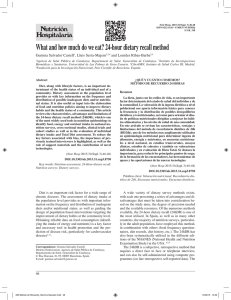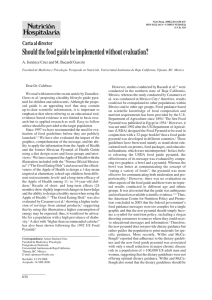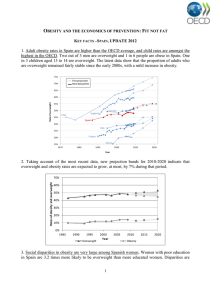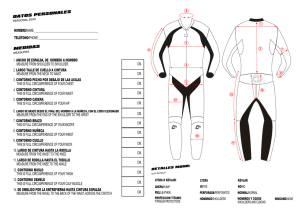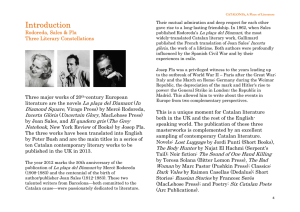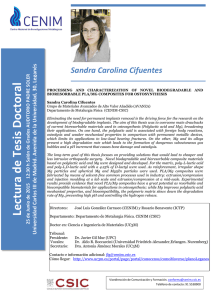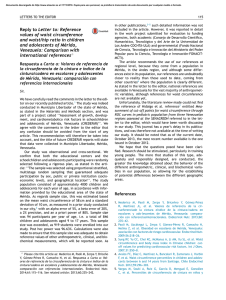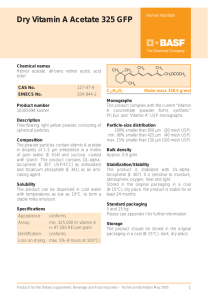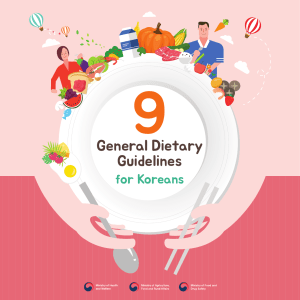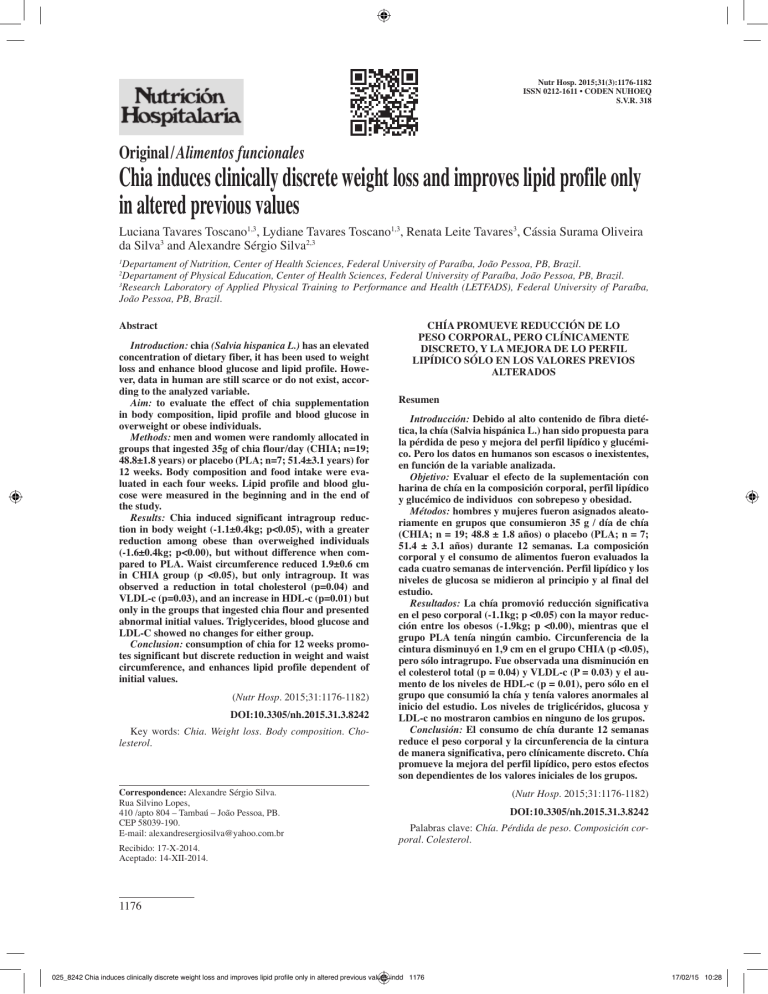
Nutr Hosp. 2015;31(3):1176-1182 ISSN 0212-1611 • CODEN NUHOEQ S.V.R. 318 Original / Alimentos funcionales Chia induces clinically discrete weight loss and improves lipid profile only in altered previous values Luciana Tavares Toscano1,3, Lydiane Tavares Toscano1,3, Renata Leite Tavares3, Cássia Surama Oliveira da Silva3 and Alexandre Sérgio Silva2,3 Departament of Nutrition, Center of Health Sciences, Federal University of Paraíba, João Pessoa, PB, Brazil. Departament of Physical Education, Center of Health Sciences, Federal University of Paraíba, João Pessoa, PB, Brazil. 3 Research Laboratory of Applied Physical Training to Performance and Health (LETFADS), Federal University of Paraíba, João Pessoa, PB, Brazil. 1 2 Abstract Introduction: chia (Salvia hispanica L.) has an elevated concentration of dietary fiber, it has been used to weight loss and enhance blood glucose and lipid profile. However, data in human are still scarce or do not exist, according to the analyzed variable. Aim: to evaluate the effect of chia supplementation in body composition, lipid profile and blood glucose in overweight or obese individuals. Methods: men and women were randomly allocated in groups that ingested 35g of chia flour/day (CHIA; n=19; 48.8±1.8 years) or placebo (PLA; n=7; 51.4±3.1 years) for 12 weeks. Body composition and food intake were evaluated in each four weeks. Lipid profile and blood glucose were measured in the beginning and in the end of the study. Results: Chia induced significant intragroup reduction in body weight (-1.1±0.4kg; p<0.05), with a greater reduction among obese than overweighed individuals (-1.6±0.4kg; p<0.00), but without difference when compared to PLA. Waist circumference reduced 1.9±0.6 cm in CHIA group (p <0.05), but only intragroup. It was observed a reduction in total cholesterol (p=0.04) and VLDL-c (p=0.03), and an increase in HDL-c (p=0.01) but only in the groups that ingested chia flour and presented abnormal initial values. Triglycerides, blood glucose and LDL-C showed no changes for either group. Conclusion: consumption of chia for 12 weeks promotes significant but discrete reduction in weight and waist circumference, and enhances lipid profile dependent of initial values. (Nutr Hosp. 2015;31:1176-1182) DOI:10.3305/nh.2015.31.3.8242 Key words: Chia. Weight loss. Body composition. Cholesterol. Correspondence: Alexandre Sérgio Silva. Rua Silvino Lopes, 410 /apto 804 – Tambaú – João Pessoa, PB. CEP 58039-190. E-mail: [email protected] Recibido: 17-X-2014. Aceptado: 14-XII-2014. CHÍA PROMUEVE REDUCCIÓN DE LO PESO CORPORAL, PERO CLÍNICAMENTE DISCRETO, Y LA MEJORA DE LO PERFIL LIPÍDICO SÓLO EN LOS VALORES PREVIOS ALTERADOS Resumen Introducción: Debido al alto contenido de fibra dietética, la chía (Salvia hispánica L.) han sido propuesta para la pérdida de peso y mejora del perfil lipídico y glucémico. Pero los datos en humanos son escasos o inexistentes, en función de la variable analizada. Objetivo: Evaluar el efecto de la suplementación con harina de chía en la composición corporal, perfil lipídico y glucémico de individuos con sobrepeso y obesidad. Métodos: hombres y mujeres fueron asignados aleatoriamente en grupos que consumieron 35 g / día de chía (CHIA; n = 19; 48.8 ± 1.8 años) o placebo (PLA; n = 7; 51.4 ± 3.1 años) durante 12 semanas. La composición corporal y el consumo de alimentos fueron evaluados la cada cuatro semanas de intervención. Perfil lipídico y los niveles de glucosa se midieron al principio y al final del estudio. Resultados: La chía promovió reducción significativa en el peso corporal (-1.1kg; p <0.05) con la mayor reducción entre los obesos (-1.9kg; p <0.00), mientras que el grupo PLA tenía ningún cambio. Circunferencia de la cintura disminuyó en 1,9 cm en el grupo CHIA (p <0.05), pero sólo intragrupo. Fue observada una disminución en el colesterol total (p = 0.04) y VLDL-c (P = 0.03) y el aumento de los niveles de HDL-c (p = 0.01), pero sólo en el grupo que consumió la chía y tenía valores anormales al inicio del estudio. Los niveles de triglicéridos, glucosa y LDL-c no mostraron cambios en ninguno de los grupos. Conclusión: El consumo de chía durante 12 semanas reduce el peso corporal y la circunferencia de la cintura de manera significativa, pero clínicamente discreto. Chía promueve la mejora del perfil lipídico, pero estos efectos son dependientes de los valores iniciales de los grupos. (Nutr Hosp. 2015;31:1176-1182) DOI:10.3305/nh.2015.31.3.8242 Palabras clave: Chía. Pérdida de peso. Composición corporal. Colesterol. 1176 025_8242 Chia induces clinically discrete weight loss and improves lipid profile only in altered previous values.indd 1176 17/02/15 10:28 Abbreviations Methods ANOVA: Analysis of variance BMI: Body mass index TC: Total cholesterol HDL: High density lipoprotein LDL: Low density lipoprotein TG: Triglycerides WHO: World Health Organization VLDL: Very low density lipoprotein WC: Waist circumference Subjects Introduction An important population behavior is a strong tendency to use foods, nutritional supplements or diets that have reporting of weight loss1,2. Often, studies show a discrete weight loss or only in abdominal region, however the information that becomes popular relates only to weight loss without the details of the magnitude. Indeed, a review of literature showed the presence of diverse nutritional supplements with a potential property of weight loss, but none showed reduction bigger than 2 kg3. It is well known that dietary fiber may promote weight loss, enhance in lipid profile and blood glucose and reduce blood pressure4-6. These fibers can lead to weight loss by delaying gastric emptying and increasing secretion of intestinal hormones which promote satiety7. Chia (Salvia hispanica L.) is a source of dietary fiber that has been investigated in recent years. Studies show that eating chia seeds can reduce systolic blood pressure, postprandial blood glucose and inflammation, and increases α-linolenic acid and plasma concentrations of eicosapentaenoic acid8-10. These results seem to have popularized the chia. However, perhaps for its rich fiber content, it was spread one concept not shown in previous studies, that chia could have slimming capacity. In fact, the unique study that tested this property was the one performed by Nieman et al.11, who found no effect of chia in slimming overweight or obese men and women. In other studies in which the properties of chia were tested for blood pressure, lipid or glucose profile, inflammation and oxidative stress, the variable body weight or waist circumference was treated as a secondary variable. Still, only one study showed that chia promoted reduction of waist circumference12. Therefore, chia has been popularly and commercially proposed to weight loss without scientific basis to support this possibility. Moreover, few studies appear insufficient to determine the impact of chia in weight loss. In this sense, the present study was conducted to evaluate the effect of chia flour (Salvia hispanica L.) supplementation for 12 weeks on body composition in middle-aged men and women with overweight and obesity grade I. Additionally, the effect of chia on lipid profile and blood glucose was evaluated. Chia induces clinically discrete weight loss and improves lipid profile only in altered previous values Individuals of both sexes were recruited to participate in a randomized, double-blind placebo controlled experimental study. Were considered as inclusion criteria: age between 35 and 65 years, BMI between 25 and 35 kg / m², sedentary, do not have the habit of consuming chia (Salvia hispanica L.) or food supplements containing active substances present in that food (dietary fiber and α-linolenic acid) and not use drugs or supplements aiming weight loss. It would be excluded from the study volunteers who, throughout the study, begun to make use of weight loss drugs or nutritional supplements, altered their eating and physical activity habits as well did not use the amount of product supplied. The project was submitted to the Ethics Committee on Human Research of the Lauro Wanderley University Hospital of the Federal University of Paraíba, being approved under protocol No. 206 338/13. All participants were informed about the research and asked to sign the Instrument of Consent as required by Resolution 196/96 of the National Health Council, which regulates the ethical aspects of researchs involving humans. The study started with 29 volunteers who were randomized (www.randomizer.org) for groups CHIA and PLA. Three subjects did not complete the study, so that the groups ended up with the following configuration: (CHIA n = 19) and (PLA, n = 7). Study design Volunteers were initially submitted to anthropometric measurements (weight, body fat, height, and waist circumference), food intake evaluation and blood samples for analysis of plasma glucose (fasting plasma glucose) and lipid profile (total cholesterol, HDL-c, LDL-c, VLDL-c and triglycerides). Then the groups started the supplementation protocols lasting 12 weeks. In every four weeks, it was conducted a nutritional evaluation through anthropometric measurements and dietary intake. Forty-eight hours after the intervention period, volunteers were tested for the same initial variables. Anthropometric evaluation For determination of body weight and fat percentage, it was used a digital balance (Tanita, BF-683W, Rio de Janeiro, Brazil) with an accuracy of 0.1 kg and 150 kg capacity and 0.1% to fat percentage. Height was measured using a portable stadiometer (Sanny, São Paulo, Brazil) with measurement scale in 0.1cm. The values of body weight and height were used to calculate the Body Mass Index (BMI, kg/m2) according to Nutr Hosp. 2015;31(3):1176-1182 025_8242 Chia induces clinically discrete weight loss and improves lipid profile only in altered previous values.indd 1177 1177 17/02/15 10:28 World Health Organization (WHO)13. Waist circumference was measured with inelastic and flexible anthropometric tape (Sanny, SN-4010, São Paulo, Brazil). For purposes of analysis of possible changes in body composition with consumption of chia, it was adopted the subdivision of CHIA group in overweight or obese, 13 according to BMI values obtained . presented in 35 grams: energy (112 kcal), carbohydrates (10.5 g), proteins (5.6 g) and dietary fiber (14.0 g). This product is considered a neutral lipid, due to the absence of total, saturated, unsaturated and trans fat and cholesterol in its chemical composition. Food intake evaluation Blood samples (10 mL) were collected after 12 hours of fasting, for the analysis of markers of lipid and glucose profile at the beginning and in the end of the study. The total cholesterol (TC), high density lipoprotein (HDL-C), triglycerides (TG) and fasting glucose were measured using commercial kits (Labtest, Minas Gerais, Brazil) in automatic analyzer LabMax 240 premium. The amounts of low density lipoprotein cholesterol (LDL-C) and very low density lipoprotein (VLDL-C) were estimated using the equation Friedewald14 [LDL-C = (TC - HDL-C) - (TG / 5)]. To assess possible changes in biochemical parameters after consumption of chia, we adopted the procedure of subdividing the CHIA group in normality or alteration in baseline biochemical variables, as recommended by the V Brazilian Guidelines on Dyslipidemia and Prevention of Aterosclerose15. The eating habits were assessed using 24-hour dietary recall, applied before of the study to define exclusion criteria and during and after the supplementation period in order to verify changes in the habitual food intake of volunteers. Two of these were representative of weekday and one weekend day. The application of food recalls and the dietary nutrient analysis were performed by a nutritionist using Avanutri software version 4.0 (Avanutri, Rio de Janeiro, Brazil). After fist nutritional evaluation, the volunteers were instructed not to change their diets during the study. In association with food recalls, issues regarding to potential gastrointestinal symptoms (constipation, diarrhea, heartburn, flatulence and nausea), allergy or intolerance attributed to the consumption of chia or placebo were added. Statistical analysis Supplementation protocols CHIA group consumed 35 g of chia flour/day for 12 weeks, added to water, yogurt, vitamins, fruit or juices, since the volunteers were already accustomed to these foods. PLA group consumed the same amount of toasted wheat bran Cacalia, Rio Grande do Sul, Brazil, following the procedure adopted by Vuksan et al.8 in a previous study. The volunteers were instructed to avoid products provided as meal replacements, but as a complement to the usual food intake and it could be eaten at any time of day, in the main meals or snacks. The delivery of the products occurred every four weeks of intervention. These were packaged in individual containers of similar appearance, in the quantity of the daily consumption. Volunteers were asked to return the packages monthly, so they could receive new products in order to ensure consumption control. All volunteers were instructed to retain the product in a cool dry place, and not subject them to any heating process. To encourage faithfulness in the consumption of the product supplied, the researchers sent messages by cell phone daily, for all who have accepted this procedure. Chia flour used in the study contained the following nutritional composition in 35 grams of product: energy (154.3 kcal), carbohydrate (3.8 g), protein (10.8 g), total fat (10.1 g), omega 3 (3.8 g), omega 6 (1.4 g), omega 9 (0.7 g) and dietary fiber (14.7 g) according to the manufacturer. The wheat flour used as a placebo, 1178 Biochemical analysis Data are presented as mean and standard error of the mean. The normality and homogeneity of data were evaluated by the Shapiro-Wilk and Levene. ANOVA for repeated measures was used in the analysis of dietary intake and anthropometry, in each four-week intervention. For comparison between CHIA and PLA groups it was used one-way ANOVA and Tukey post hoc. Biochemical parameters were analyzed by paired and independent t test. The analysis were performed in GraphPad Instat 3.0 software (San Diego, CA, USA), adopting a statistical significance of p<0.05 for all test. Results Groups showed similarities for all variables at baseline. They were middle-aged adults (48.8 ± 2 and 51.4 ± 3 years for CHIA and PLA groups, respectively) with no significant difference between them. Volunteers from both groups were overweight or obese, showed high waist circumference, hyperlipidemia and slightly increased blood glucose at baseline, but without a diagnosis of diabetes. The pre intervention values after chia group divided by normal and abnormal values of BMI, blood glucose and lipid profile are presented in table I and II. Groups showed normal consumption of carbohydrates, proteins and lipids at baseline. The average daily intake of calories, macronutrients, and dietary fiber Nutr Hosp. 2015;31(3):1176-1182 025_8242 Chia induces clinically discrete weight loss and improves lipid profile only in altered previous values.indd 1178 Luciana Tavares Toscano et al. 17/02/15 10:28 Table I Anthropometric data of CHIA and PLA groups at baseline and every four weeks of study Table II Biochemical parameters evaluated at baseline and after 12 weeks of study CHIA CHIA General (n=19) PLA Overweight Obesity (n=8) (n=11) (n=7) Weight (kg) Baseline 83.6±2 77.8±3 88.7±2 79.6±7 Week 4 83.0±2 77.8±3 87.6±2 79.3±7 Week 8 83.3±2 77.8±3 88.2±2 80.0±7 Week 12 82.5±2* 77.4±3 87.1±2*** 79.4±7 BMI (kg/m²) Baseline Week 12 Baseline Week 12 Blood glucose (mg/dL) General (n=19) 112.1±7 114.7±5 Normal (n=6) 93.0±1 98.5±2 Abnormal (n=13) 120.9±9 122.3±7 104.0±6 General (n=19) 239.2±18 219.8±11 240.1±15 229.0±14 Normal (n=6) 167.7±4 187.7±17 Abnormal (n=13) 272.3±20 234.6±12* 31.5±1 28.2±0 34.1±1 32.0±3 HDLc (mg/dL) Week 4 31.3±1 28.2±0 33.8±1 32.0±3 General (n=19) 40.9±3 41.8±2 Week 8 31.4±1 28.2±0 34.0±1 32.2±3 Normal (n=6) 51.1±2 44.1±4 31.8±3 39.8±2** Week 12 31.2±1 28.1±0 33.7±1 32.0±3 Abnormal (n=13) 40.8±4 39.8±3 LDLc (mg/dL) General (n=19) 163.2±17 147.8±11 134.1±14 132.1±9 Baseline 34.5±2 30.8±3 36.5±3 34.2±3 Normal (n=6) 66.3±26 Week 4 34.9±2 31.9±3 36.6±3 36.6±3 Abnormal (n=13) 171.8±18 153.0±12 Week 8 34.6±2 32.1±3** 36.1±3 34.6±3 VLDLc (mg/dL) Week 12 35.6±2 32.0±3 37.9±2* 36.7±3 WC (cm) 105.8±7 TC (mg/dL) Baseline Fat (%) PLA (n=7) 98.3±17 General (n=19) 41.3±8 33.9±5 Normal (n=6) 22.8±2 32.5±8 Abnormal (n=13) 81.5±14 36.8±4*** Baseline 98.6±2 92.9±3 103.2±1 99.3±6 Week 4 97.0±2* 91.3±3 101.7±1 99.7±6 General (n=19) Week 8 97.4±2 91.1±3 102.4±1 98.2±6 Normal (n=6) Week 12 96.7±2* 90.9±3 101.4±1 98.1±6 42.3±8 48.1±8 TG (mg/dL) Abnormal (n=13) 214.1±40 151.8±22 215.0±34 259.0±38 89.8±8 95.7±11 352.3±56 214.3±35 BMI = body mass index; WC = waist circumference. Data are expressed as mean ± standard error. *p <0.05; ** P = 0.03; *** p <0.00; differences from baseline; ANOVA for repeated measures. TC = total cholesterol; HDLc = high density lipoprotein; LDLc = low density lipoprotein; VLDLc = very low density lipoprotein; TG = triglycerides. Data are expressed as mean ± standard error. *p = 0.04; **p = 0.01; ***p = 0:03, difference from baseline; paired t test. during the intervention period showed no significant differences from baseline (table III). However, it was observed that CHIA group exhibited increased protein intake on the fourth week compared to PLA. Body weight significantly decreased in CHIA group after 12 weeks of intervention compared to baseline (table I) with a reduction of 1.1±0.4 kg. However, when this group was subdivided into subjects with overweight and obesity, it was noted that the decrease in body weight was observed only in the obese subgroup (1.6±0.4 kg), whereas overweight group showed only 0.4±0.2 kg reduction. We could also observe that the statistical difference occurred only in intragroup analysis, so that the weight at the end of the interven- Chia induces clinically discrete weight loss and improves lipid profile only in altered previous values Nutr Hosp. 2015;31(3):1176-1182 025_8242 Chia induces clinically discrete weight loss and improves lipid profile only in altered previous values.indd 1179 1179 17/02/15 10:28 Table III Average daily intake of energy, macronutrients and dietary fiber of the volunteers CHIA (n=19) PLA (n=7) Baseline Week 4 Week 12 Baseline Week 4 Week 12 1669.6±126 1739.8±112 1624.1±88 1742.0±155 1624.0±164 1677.1±143 219.5±18 225.9±18 209.0±13 261.6±22 214.9±28 215.1±22 Protein (g) 74.5±6 92.9±6# 89.0±8 62.7±8 56.8±6 75.5±10 Fat (g) 47.1±5 56.9±6 43.6±5 42.5±7 46.1±6 51.8±7 Fibers (g) 14.3±2 15.2±2 16.2±1 13.5±3 14.2±1 14.5±2 Energy (kcal) Carbohydrate (g) Data are expressed as mean ± standard error. # Difference from the placebo group, p <0.05; one way ANOVA test. tion did not differ between CHIA and PLA groups. Since it was not possible to subdivide the PLA group in overweight and obesity, this analysis was conducted only among groups CHIA (without subdivision) versus PLA. Despite the reduction in body weight in CHIA group, there was no reduction in the percentage of fat in this group. On the contrary, CHIA group showed an increase in body fat when this group was divided into subgroups of overweight and obesity. BMI did not change in either group. Waist circumference significantly decreased in the fourth and 12th weeks of study in volunteers who consumed chia (1.9±0.6 cm), without this phenomenon has been noted when the analysis was performed in subgroups of overweight and obesity. Despite the reduction observed, CHIA group did not finish the intervention with lower waist circumference compared to the PLA group. Biochemical parameters did not change in groups CHIA and PLA. However, when subdividing CHIA group for normal or altered serum concentration, there was a reduction in total cholesterol (13.8%) and VLDL-C (54.8%) and an increase in HDL-c (25%) in the subgroup of volunteers who consumed chia and had abnormal values at baseline. Triglycerides, glucose and LDL-c exhibited no changes in any of the groups (table II). Discussion The present study demonstrated that 12 weeks of supplementation with 35 g of chia flour/day caused a significant reduction in body weight and waist circumference, but this reduction was observed only in the intragroup analysis and clinically discrete. Furthermore, the supplementation was able to enhance the serum concentration of TC, VLDL-C and HDL-C, but only when considered volunteers who presented abnormal values at baseline for these variables. 1180 Dietary fiber may improve satiety, decrease caloric intake and promote weight loss4,16. Chia flour and placebo used in the study contain similar amounts of dietary fiber. However, the fibers present in chia have high viscosity leading to gel formation in gastrointestinal tract17 that may confer to this food an additive effect on satiety, as demonstrated by Vuksan et al9, while placebo does not have this property of viscosity. The high content of omega-3 present in chia can help to reduce obesity by suppressing appetite, improving lipid oxidation and energy expenditure and reducing fat deposition, although these effects are only clearly evident in studies with animals18. Despite these likely slimming possibility, few clinical studies have shown that intake of dietary fiber has a positive effect on weight control5. When specifically chia was studied it was only demonstrated increased satiety9 despite this seed contain about 30% fibers19. Meanwhile, the ability of chia to promote bodyweight reduction had only been investigated in three studies, at least to our knowledge. Our findings demonstrate reduction in body weight with consumption of chia, which was not observed in previous studies that evaluated body composition after consumption of that food. Nieman et al.11 demonstrated that the ingestion of 50 g of chia seed/day, for 12 weeks, was not able to reduce the body weight in obese or overweight subjects. Vuksan et al.8 demonstrated that ingestion of 37g of chia seeds/day for 12 weeks did not alter body weight in type 2 diabetic subjects with overweight. In this study, participants were instructed to consume a diet according to the nutritional recommendations of the Canadian Diabetes Association, which includes the daily intake of 25 to 35 g of dietary fiber. However, even with the adoption of a standard diet, and amounts of chia and period of use similar to our study, no body weight changes were observed in these individuals. Likewise, Nieman et al. 20 found that 25 g of chia seeds/day, for 10 weeks had no Nutr Hosp. 2015;31(3):1176-1182 025_8242 Chia induces clinically discrete weight loss and improves lipid profile only in altered previous values.indd 1180 Luciana Tavares Toscano et al. 17/02/15 10:28 effect on body composition in overweight women, but the period of use of chia was lower than ours. It is noteworthy that the present study followed the possible changes in body weight every four weeks of intervention, which was not adopted in previous studies. However, the difference in body weight did not appear until the end of the 12 weeks of supplementation with flour chia. Despite these findings, Egras et al.21 stated that data are still limited to suggest the use of chia seeds in weight loss, although considered safe in short term. Our study had the longest intervention, along with Vuksan et al.8 and Nieman et al.11 who also supplemented for 12 weeks. Considering the weight reduction only in our study, and that this phenomenon was only observed at 12 weeks, still with a clinically discrete magnitude, there is still a need to investigate whether protocols with longer periods of supplementation promote more weight loss. Waist circumference in CHIA group reduced in the fourth week of supplementation, as well as in the end of the intervention. Although previous studies with consumption of chia isolated had not analyzed this parameter, Guevara-Cruz et al.12 corroborate our findings by showing reduction in waist circumference (95.7 ± 8.6 vs 93.0 ± 8.9cm, p <0.0001) after consumption standard diet containing chia seeds, soy, nopal and oats by individuals with metabolic syndrome. However, this result was probably due to calorie reduction in the habitual diet (-500kcal), since the placebo group also showed decreased waist circumference (95.2 ± 9.0 vs 92.1 ± 9.0cm, p <0.0001). The decrease in waist circumference observed in our study was more discrete in relation to these data, but this phenomenon is easily explained by the fact that this previous study linked the consumption of chia with other grains and with a reduction in caloric intake, which alone can already promote waist circumference reduction, as actually occurred in control. Previous studies using animal models showed robust results of consumption of chia in lipid profile. Reduction in visceral adiposity, prevention of dyslipidemia, hypertriglyceridemia normalization22; improvement in adipose tissue and lipid metabolism dysfunction23; lipid redistribution24; decrease in serum triglycerides and increased HDL-C were observed in rats25. However, data in humans are more inconsistent. Biochemical parameters evaluated in this study showed change only when subdividing the group CHIA as normal or modified basal serum values to total cholesterol and VLDL-c and increasing serum concentrations of HDL-c. Serum triglyceride levels showed no differences, as opposed to the result found by Guevara-Cruz et al.12 that demonstrated lowering serum triglycerides (-284.0 mg / dL) with the use of standard diet containing chia seeds and other grains, for two months in individuals with metabolic syndrome. However, this effect cannot be attributed solely to chia, since other grains have been consumed in combination. The absence of alterations in subjects with pre- Chia induces clinically discrete weight loss and improves lipid profile only in altered previous values viously normal values corroborates Vuksan et al.8 and Nieman et al.11, who also found no changes in serum lipids in subjects similar to those considered normal in our study initial conditions. As for blood glucose, our findings do not suggest changes in any of the groups. Unlike, Vuksan et al.9 demonstrated a reduction of postprandial blood glucose by consuming different amounts of chia (7, 15 and 24 g), in healthy subjects. Moreover, our data corroborate Vuksan et al.8, Nieman et al.11 and Nieman et al.20 who found no differences in concentrations of fasting glucose in diabetics and overweight and obese individuals. The small sample size of the PLA group made it impossible the formation of subgroups for assessment of body composition and biochemical parameters, as adopted for CHIA group, constituting the main limitation that we can see for this study. Thus, comparisons between groups could only be carried out between the groups PLA and CHIA without division into subgroups. Considering that the effects observed in this study were only noted at 12 weeks, our data point out the need of further studies with longer duration intervention, and sample size that allows the stratification of subjects according to body weight and biochemical profile in both experimental and placebo groups. Taken together, our data show that consumption of 35 g of chia flour for 12 weeks can reduce body weight and waist circumference significantly, but clinically discrete in overweight or obese individuals. It promotes improvement in lipid profile with more clinically relevant magnitude, but these effects of chia consumption are dependent on the initial values of groups for body composition as for the lipid profile. References 1. Vaughan RA, Conn CA, Mermier CM. Effects of Commercially Available Dietary Supplements on Resting Energy Expenditure: A Brief Report. ISRN Nutrition 2014; 2014: 1-7. 2. Leidy HJ. Increased dietary protein as a dietary strategy to prevent and/or treat obesity. Mo Med 2014;111(1):54-8. 3. Manore MM. Dietary supplements for improving body composition and reducing body weight: where is the evidence?. Int J Sport Nutr Exerc Metab 2012; 22(2):139-54. 4. Lattimer JM, Haub MD. Effects of Dietary Fiber and Its Components on Metabolic Health. Nutrients 2010; 2:1266-1289. 5. Babio N, Balanza R, Basulto J, Bulló M, Salas-Salvadó J. Dietary fibre: influence on body weight, glycemic control and plasma cholesterol profile. Nutr Hosp 2010;25(3):327-340. 6. Whelton SP, Hyrea AD, Pedersen B, Yi Y, Whelton PK, He J. Effect of dietary fiber intake on blood pressure: a meta-analysis of randomized, controlled clinical trials. J Hypertension 2005; 23:475–481. 7. Anderson JW, Baird P, Davis Jr JH, Ferreri S, Knudtson M, Koraym A et al. Health benefits of dietary fiber. Nutrition Reviews 2009; 67(4):188–205. 8. Vuksan V, Whitham D, Sievenpiper JL, Jenkins AL, Rogovik AL, Bazinet RP et al. Supplementation of Conventional Therapy With the Novel Grain Salba (Salvia hispanica L.) Improves Major and Emerging Cardiovascular Risk Factors in Type 2 Diabetes. Diabetes Care 2007; 30 (11):2804-2810. 9. Vuksan V, Jenkins AL, Dias AG, Lee AS, Jovanovski E, Rogovik AL et al. Reduction in postprandial glucose excursion and Nutr Hosp. 2015;31(3):1176-1182 025_8242 Chia induces clinically discrete weight loss and improves lipid profile only in altered previous values.indd 1181 1181 17/02/15 10:28 10. 11. 12. 13. 14. 15. 16. 17. 18. prolongation of satiety: possible explanation of the long-term effects of whole grain Salba (Salvia Hispanica L.). European Journal of Clinical Nutrition 2010; 64:436–438. Jin F, Nieman DC, Sha W, Xie G, Qiu Y, Jia W. Supplementation of Milled Chia Seeds Increases Plasma ALA and EPA in Postmenopausal Women. Plant Foods Hum Nutr 2012. Nieman DC, Cayea EJ, Austin MD, Henson DA, McAnulty SR, Jin F. Chia seed does not promote weight loss or alter disease risk factors in overweight adults. Nutrition Research 2009; 29: 414–418. Guevara-Cruz M, Tovar AR, Aguilar-Salinas CA, Medina-Vera I, Gil-Zenteno L, Hernandez-Viveros I et al. A Dietary Pattern Including Nopal, Chia Seed,Soy Protein, and Oat Reduces Serum Triglycerides and Glucose Intolerance in Patients with Metabolic Syndrome. J Nutr 2012; 142: 64–69. World Health Organization-WHO. Physical status: the use and interpretation of anthropometry. Genebra, 1995. Friedewald WT, Levy RI, Fredrickson DS. Estimation of the concentration of low-density lipoprotein cholesterol in plasma, without use of the preparative ultracentrifuge. Clinical Chemistry 1972;18 (6): 499-502. Xavier HT, Izar MC, Faria Neto JR, Assad MH, Rocha VZ, Sposito AC et al. V Diretriz Brasileira de Dislipidemias e Prevenção da Aterosclerose. Arq Bras Cardiol 2013. Tucker LA, Thomas KS. Increasing total fiber intake reduces risk of weight and fat gains in women. J Nutr 2009; 139: 576-581. Capitani MI, Spotorno V, Nolasco SM, Tomás MC. Physicochemical and functional characterization of by-products from chia (Salvia hispanica L.) seeds of Argentina. LWT - Food Science and Technology 2012; 45:94-102. Buckley JD, Howe PRC. Long-Chain Omega-3 Polyunsaturated Fatty Acids May Be Beneficial for Reducing Obesity—A Review. Nutrients 2010; 2:1212-1230. 1182 19. Ixtaina VY, Nolasco SM, Tomás MC. Physical properties of chia (Salvia hispanica L.) seeds. Industrial Crops and Products 2008; 2 8: 286–293. 20. Nieman DC, Gillitt N, Jin F, Henson DA, Kennerly K, Shanely RA et al. Chia Seed Supplementation and Disease Risk Factors in Overweight Women: A Metabolomics Investigation. The Journal of Alternative and Complementary Medicine 2012;18 (7):700-708. 21. Egras AM, Hamilton WR, Lenz TL, Monaghan MS. An Evidence-Based Review of Fat Modifying Supplemental Weight Loss Products. Journal of Obesity 2011; 2011: 1-7. 22. Chicco AG, D’Alessandro ME, Hein GJ, Oliva ME, Lombardo YB. Dietary chia seed (Salvia hispanica L.) rich in a-linolenic acid improves adiposity and normalises hypertriacylglycerolaemia and insulin resistance in dyslipaemic rats. British Journal of Nutrition 2009; 101:41–50. 23. Oliva ME, Ferreira MR, Chicco A, Lombardo YB. Dietary Salba(Salvia hispanica L) seed rich in α-linolenic acid improves adipose tissue dysfunction and the altered skeletal muscle glucose and lipid metabolism in dyslipidemic insulin-resistant rats. Prostaglandins Leukotrienes and Essential Fatty Acids 2013; 1-11. 24. Poudyal H, Panchal SK, Waanders J, Ward L, Brown L. Lipid redistribution by α-linolenic acid-rich chia seed inhibits stearoyl-CoA desaturase-1 and induces cardiac and hepatic protection in diet-induced obese rats. Journal of Nutritional Biochemistry 2012; 23: 153–162. 25. Ayerza R, Coates W. Effect of Dietary - Linolenic Fatty Acid Derived 26. from Chia when Fed as Ground Seed, Whole Seed and Oil on Lipid Content and Fatty Acid Composition of Rat Plasma. Ann Nutr Metab 2007;51:27–34. Nutr Hosp. 2015;31(3):1176-1182 025_8242 Chia induces clinically discrete weight loss and improves lipid profile only in altered previous values.indd 1182 Luciana Tavares Toscano et al. 17/02/15 10:28
